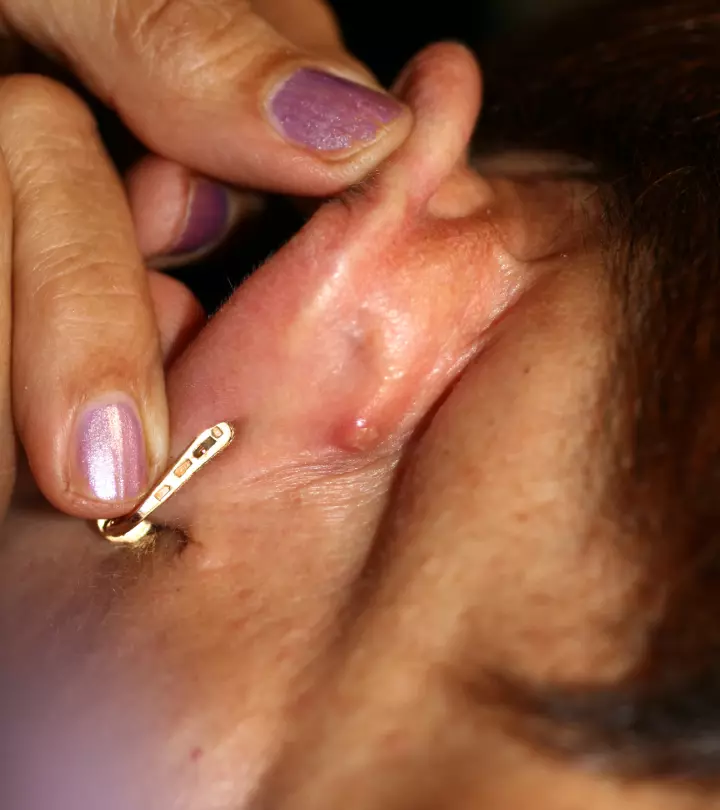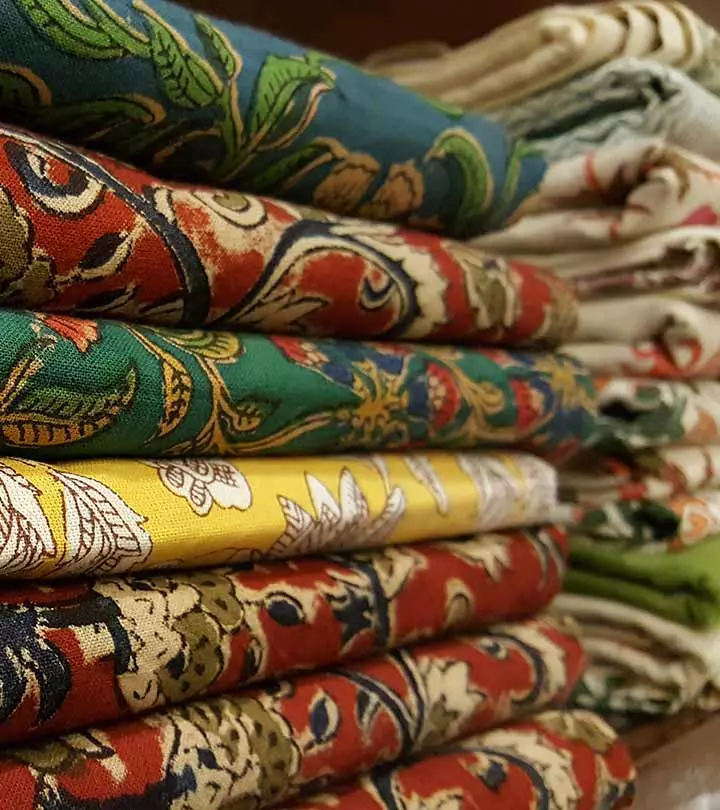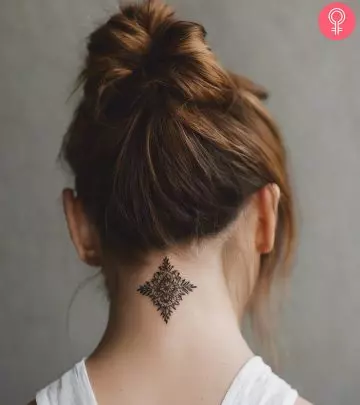Eyebrow Piercing Scar: Treatment And Prevention Tips
Embrace your bold and stunning piercing without letting the scars ruin the look.

Image: Shutterstock
Getting an eyebrow piercing is an exciting journey of self-expression. Yet the possibility of potential scarring can be a lingering concern and affect your confidence. An eyebrow piercing scar may shift the viewer’s focus from admiring the style to being critical of the mark it left. This article guides you through the intricacies of treating and preventing eyebrow piercing scars, empowering you with the knowledge to maintain the aesthetic integrity of your chosen adornment. From tips to prevent scar formation to implementing effective solutions and treatments, you will discover valuable insights to navigate the world of eyebrow piercings confidently. Read on.
In This Article
What Are Eyebrow Piercing Scars?

Eyebrow piercing scars are healed tissues signalling tissue damage at the piercing site. These scars can appear to be raised, rigid, and discolored tissues, or depressions in the skin. They may be caused due to incorrect piercing techniques, incompatible jewelry types, and poor aftercare. When a piercing hole is made on your skin, your body’s natural response is to increase collagen production at the piercing site to repair the damage. However, this process can sometimes result in an overproduction of collagen, which leads to the formation of scars (1). Further, jewelry migration or rejection, or infections can increase the risk of scarring.
Chelsea, a blogger, shares her experience of getting her eyebrow pierced. She writes, “Finally I got my eyebrow pierced. This is another piercing which was painless but bled a lot (i).” She also mentions that even though it has been seven months, it still swells up and hurts. She continues, “I took it out but it has left a really big scar so I put the bar back in to hide it.”
Understanding the different types of piercing scars is essential to choosing the right course of action for their prevention. Here are the common types of scars that may develop around your Eyebrow piercing:
- Hypertrophic Scars: Thick, raised scars that develop at the piercing site because of excessive collagen production in response to the piercing trauma (2).
- Keloid Scars: Thick lumped scar tissues, similar to hypertrophic scars, but extend slightly beyond the original piercing site. They can be itchy or painful (2).
- Atrophic Scars: These scars appear as tiny indentations in the skin around the piercing hole. They are usually caused by the loss of underlying tissues during the healing period.
- Discoloration: Sometimes, scars may appear simply as hyperpigmented or hypopigmented spots surrounding the piercing area, causing a contrasting and noticeable color change with the skin surrounding the piercing (1).
 Trivia
TriviaProtecting the piercing is crucial to avoid scar formation. Scroll down to understand the preventive measures you may take to minimize the risk of scarring.
Key Takeaways
- Stay vigilant for signs of scar formation, such as raised tissue, discoloration, or irregular texture around your eyebrow piercing.
- Choose a quality piercer who follows proper hygiene and techniques to minimize complications and reduce the risk of eyebrow piercing scars.
- Opt for high-quality jewelry made from materials like gold and titanium to reduce the likelihood of metal allergies and scar formation.
- Explore suitable treatment options like silicone gels, medicated creams, or laser treatments that will help minimize the appearance of scars.
Tips For Preventing Eyebrow Piercing Scars
The chances of scars forming around your eyebrow piercing are always high, but there are ways to avoid them. Follow these expert tips for a smooth healing process:
- Choose A Skilled Piercer: Research and find a reputable piercer who follows proper hygiene and correct piercing techniques in their practice to minimize the risk of complications.
- Get Suitable Jewelry: Opt for top-quality jewelry, preferably made from hypoallergenic materials like titanium, 12-14k gold, or surgical stainless steel, especially if you have skin sensitivity. These metals have a lower probability of causing allergic reactions (3).
- Watch Out For Signs Of Rejection: Keep an eye out for signs of piercing rejection, like excessive redness, swelling, or jewelry migration. If you suspect your body is rejecting the piercing jewelry, go to your piercer for early detection and treatment.
- Practice Good Aftercare: Diligently follow the proper aftercare methods suggested by your piercer. Do not use harsh antibacterial soaps and products containing alcohol or hydrogen peroxide while cleaning or nursing the piercing site, as they can irritate the skin (4).
- Avoid Sleeping On A New Piercing: Do not sleep on your eyebrow piercing, as it can cause pressure and friction at the site, which may lead to irritation and delayed healing. Try sleeping on your back or find another comfortable position that avoids direct contact or strain on the piercing site.
- Limit Touching The Jewelry: Avoid excessively touching or playing with the piercing jewelry, as this can open up the wound. That could disrupt the healing process and increase the risk of an infected eyebrow piercing and scar formation.
Despite the best precautions, aftercare, and follow-up measures, some people may still develop scars. Scroll down to learn what you can do to manage scars that have already appeared.
How To Treat Eyebrow Piercing Scars

Managing eyebrow piercing scars can be a challenge. But there are a few ways to effectively minimize their appearance and promote healthy skin. Here are a few treatment options to consider for eyebrow piercing scar reduction.
- Silicone-Based Scar Gels Or Sheets: Apply silicone gels or sheets to the affected area regularly to help flatten the scar tissue and reduce its visibility (5).
- Medicated Creams Or Ointments: Use medicated ointments containing potent ingredients such as corticosteroids or onion extract that promote scar healing and improve skin texture (6).
- Laser Therapy: Consider laser therapy options that use pulsed dye lasers and steroid injections to effectively target scar tissue, leading to smoother skin texture and reducing the visibility of the scars (7).
 Pro Tip
Pro TipThese treatments can help you effectively reduce eyebrow piercing scars. Until they are completely gone, you may need to conceal the appearance of the piercing scars over your eyebrows. Try clever makeup applications for it.
How To Use Makeup To Cover An Eyebrow Piercing Scar

Eyebrow piercing scars can occur even after taking careful measures. But fret not! makeup can be a valuable tool in softening the intensity of these scars, making them less noticeable. Follow these expert makeup tips to camouflage your eyebrow piercing scars flawlessly.
- Start With A Clean Canvas: Cleanse and moisturize the rest of your face and clean your piercing with some saline solution and cotton pads.
- Apply Primer: Use a silicone-based primer to fill in uneven textured skin around the scars to create a smooth base for makeup application.
- Use A Concealer: Apply a concealer that matches your skin tone directly onto the scarred piercing using your fingertip or a small applicator brush.
- Blend Well: Use a makeup sponge or brush to blend the concealer seamlessly into the surrounding skin, ensuring a natural-looking finish.
- Set The Look: Dust setting powder or use some setting spray over the concealed area to lock the makeup in place. The setting products also prevent smudging throughout the day.
If you are new to makeup, these steps might take a bit of practice, but they are quite helpful in temporarily concealing scars or pigmentations on the skin.
Eyebrow piercings are prone to scarring. While you may not be able to control all the factors that may lead to scarring, you can minimize their appearance by taking appropriate measures. It is ideal to always consult an experienced piercer and diligently follow the aftercare suggested by them. Also, be careful with selecting jewelry material and get tested for allergies beforehand to reduce the likelihood of health complications and scarring. However, should scars develop, various treatment options are available to help fade them, from topical silicone scar therapy gels to advanced laser treatments. Embracing these treatment and prevention tips empowers you to confidently express your individuality through eyebrow piercings while ensuring a smooth, scar-free aesthetic.
Frequently Asked Questions
Are there any natural remedies to treat eyebrow piercing scars?
Yes, natural remedies like aloe vera gel, rosehip oil, or vitamin E oil may help improve the appearance of eyebrow-piercing scars over time. However, results may vary depending on the individual skin type and the scar’s severity. It is always best to consult a dermatologist for personalized advice.
Do eyebrow piercings always leave a scar?
Not all eyebrow piercings may leave behind a scar, but there is always a high probability. Eyebrow piercings can leave a scar at the entry and exit points of the piercing, which may be barely noticeable for some. However, factors such as incorrect piercing techniques, metal allergy, migration, or infection may affect the healing process and leave visible scars.
Is an eyebrow piercing scar permanent?
Yes. An eyebrow piercing scar is permanent. However, a majority of the scars tend to fade over time and are barely visible. It is best to choose an experienced piercer and follow proper aftercare measures to reduce the risk of scar formation.
Can I get an eyebrow piercing if I have a history of keloid scars?
It is best to avoid getting an eyebrow piercing if you have a history of bothersome keloid scars, as you might develop them on the eyebrow piercing site. Always consult a dermatologist or an experienced piercer beforehand to assess potential risks and arrive at appropriate solutions.
How long does an eyebrow scar last?
Hypertrophic scars may take a few months to a year to heal properly and fade. However, large, raised scars may take longer to heal. Keloid scars may keep growing for several years and may even return after treatment (8). Therefore, it is best to work with a doctor and an experienced piercing professional beforehand to reduce the risk of scars and ensure proper healing.
Why are vertical eyebrow piercings more prone to scarring?
Vertical eyebrow piercings may be more prone to scarring due to increased tension on the skin, prolonged healing time, and potential for jewelry movement, leading to a greater risk of scar formation.
What massage techniques can help minimize the eyebrow piercing scar?
You may apply light pressure and massage the scar in circular motions or tap on it gently to improve blood circulation and minimize the appearance of hypertrophic piercing scars. While some studies show that massage may have some effect on reducing scar thickness, results are conflicting and demand further research to prove massage therapy’s efficacy in scar management (9).
Like all piercings, eyebrow piercings also have their own set of pros and cons. It may be less painful than any other piercing, but the chances of migration and rejection are high. Click play on the video below to learn more.
Personal Experience: Source
StyleCraze's articles are interwoven with authentic personal narratives that provide depth and resonance to our content. Below are the sources of the personal accounts referenced in this article.
(i). My piercing experiencehttps://chelseaswriting.wordpress.com/2012/07/11/my-piercing-experience/
References
Articles on StyleCraze are backed by verified information from peer-reviewed and academic research papers, reputed organizations, research institutions, and medical associations to ensure accuracy and relevance. Read our editorial policy to learn more.
- Hypertrophic Scarring and Keloids: Pathomechanisms and Current and Emerging Treatment Strategies
https://www.ncbi.nlm.nih.gov/pmc/articles/PMC3022978/ - Hypertrophic Scarring
https://www.ncbi.nlm.nih.gov/books/NBK470176/# - Management of Keloids and Hypertrophic Scars
https://www.aafp.org/pubs/afp/issues/2005/1115/p2029.html - Suggested Aftercare For Body Piercings
https://safepiercing.org/aftercare/ - The Efficacy of Silicone Gel for the Treatment of Hypertrophic Scars and Keloids
https://www.ncbi.nlm.nih.gov/pmc/articles/PMC2918339/ - A comparative study evaluating the tolerability and efficacy of two topical therapies for the treatment of keloids and hypertrophic scars
https://pubmed.ncbi.nlm.nih.gov/20480794/ - Management of Keloids and Hypertrophic Scars
https://www.aafp.org/pubs/afp/issues/2009/0801/p253.html - Hypertrophic Scarring and Keloids: Pathomechanisms and Current and Emerging Treatment Strategies
https://www.ncbi.nlm.nih.gov/pmc/articles/PMC3022978/ - Physical Management of Scar Tissue: A Systematic Review and Meta-Analysis
https://www.ncbi.nlm.nih.gov/pmc/articles/PMC7578190/
Read full bio of Ikramul Haque Shazib
Read full bio of Shreya Mukherjee
Read full bio of Asmita De
Read full bio of Pahul Nanra


























Community Experiences
Join the conversation and become a part of our empowering community! Share your stories, experiences, and insights to connect with other beauty, lifestyle, and health enthusiasts.